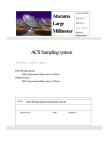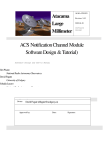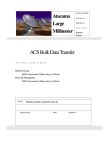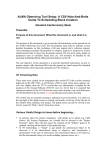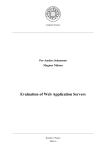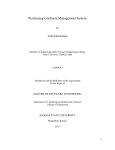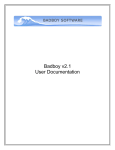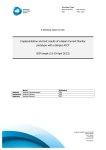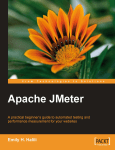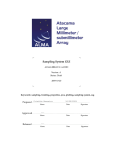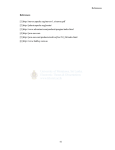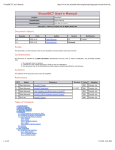Download ACS Performance Test
Transcript
ACS Performance Test
User's Documentation
Document Owner:
Anze Zagar
Status:
Draft
Availability:
eso:/doc/DOCACS_Performance_Test.xml
Creation:
20040312 (Anze Zagar) Last Modification:
20040813 (Steve Harrington) Copyright © 2004 by Cosylab d.o.o. All Rights Reserved.
Scope
This document gives instructions on how to execute and extend the performance test suite. Also, it gives a report on the results of some of these ACS stress and performance tests, which were performed at CosyLab. Audience
Anyone interested in ACS performance testing, in particular ACS developers and prospective users. Table of Contents
1. Introduction
1.1. Testing Computers
2. Tests
2.1. Notes
3. Preparation of tests
3.1. ACS components/devices
3.2. Pereparation of CDB
3.3. ComponentClients
3.4. jMeter clients
3.5. Preparation of jMeter test plan
3.6. DistSync
4. Installing and Running the tests
5. Expectations
5.1. Scalability
5.2. Effects of different parameters
6. Results
7. Conclusions
7.1. Possible extensions of the tests
8. How to extend tests
8.1. Creating jMeter sampler client class
8.2. Creating jMeter test plan
References
Document History
How to Read this Document
This document's metainformation (authors, revision history, table of contents, ...) can be found above. What follows below is the body of the document. The body is composed of several sections, which may be further composed of subsections. Typographical styles are used to denote entities of different kinds. For a full list of entities and their respective typographic conventions, please refer to the Styles section of the XML Documentation document. When viewing the document in a nonprinted form, it is possible to submit comments regarding a given section to the document's owner. This is achieved by clicking the mail icon next to the section title. For this to work, your mail must be configured to properly handle the mailto URLs. 1. Introduction The ACS performance evaluation suite consists of the following kinds of tests:
1. Startup tests: gathering data on the startup time of individual components. 2. Throughput tests: finding the throughput of individual operations. 3. Scalability tests: determining the limits where the server can still keep up with the client requests and remain stable. To facilitate multipleclient stress testing, Apache JMeter application [3] was used. JMeter allows for creating automatically executable test plans. Additional ACSspecific plugins for JMeter were developed. The tests were performed on a simple home environment and involved three Linux desktops, one of which was used as a standalone ACS server runnig only jmanager and one C++ container. All components used for these tests were bulit in C++ whereas clients were all Java made.
Analysis of the data collected by jMeter was later made manually in OpenOffice.org Calc.
1.1. Testing Computers Computer
Processor
Memory
Operating System
Other Information
•
Thor/192.168.1.4
Odin/192.168.1.5
Intel Celeron, 768MB 1.8GHz, 128kB RAM
cache
Fedora Core 1 (kernel 2.6.2)
Intel Pentium 4, Debian Linux 2.5GHz, 512kB 1GB RAM
(kernel 2.6.3)
cache
•
•
Running in text mode •
•
Primary client J2RE
SE 1.4.2_02b03 •
Running in X, ICEWM •
Secondary Client J2RE
SE 1.4.2_02b03 Controlled remotely via SSH •
Heimdall/192.168.1.1
AMD Athlon, 768MB 850MHz, 256kB RAM
cache
Debian Linux (kernel 2.4.22)
ACS Server (ACS3.1.pre
20040107) J2RE
SE 1.4.2_03b02 •
•
Home server, routher, firewall During testing there was also another Windows 98 computer connected to the network.
2. Tests The following tests are implemented: 1. Startup tests: 1. CORBA initialization: 1. TEST_1_1_1: Server [analyze acsStart logs] 2. TEST_1_1_2: Client [do ComponentClient::initCorba()] 2. Device activation on server startup: 1. TEST_1_2_1: Export/activate N={1,2,4,8,16} simple devices [prepare CDB and analyze acsStartContainer logs] 2. TEST_1_2_2: Export/activate N={1,2,4,8,16} complex devices [prepare CDB and analyze acsStartContainer logs] 3. TEST_1_2_3: Stop container with N={1,2,4,8,16} simple devices activated [analyze acsStartContainer logs] 4. TEST_1_2_4: Stop container with N={1,2,4,8,16} complex devices activated [analyze acsStartContainer logs] 3. Device activation from client: 1. TEST_1_3_1: Connect to N={1,2,4,8,16} simple not yet activated devices [do getComponent() for each] 2. TEST_1_3_2: Connect to N={1,2,4,8,16} complex not yet activated devices [do getComponent() for each] 3. TEST_1_3_3: Time for client to release all N={1,2,4,8,16} simple devices [do releaseComponent() for each] 4. TEST_1_3_4: Time for client to release all N={1,2,4,8,16} complex devices [do releaseComponent() for each] 2. Throughput tests (measuring operations per second = 1 / time of one operation): 1. Synchronous operations (N={1,2,4,8,16} clients distrubited on M={1,2,4} machines): 1.
2.
3.
4.
5.
TEST_2_1_1: getProperty() 1.
2.
3.
4.
5.
6.
TEST_2_2_1_1: getProperty() [only send requests] TEST_2_1_2: setProperty() TEST_2_1_3: Device::getCharacteristic() TEST_2_1_4: Property::getCharacteristic() TEST_2_1_5: action() 2. Asynchronous operations (N={1,2,4,8,16} clients distrubited on M={1,2,4} machines, callbacks are empty): TEST_2_2_1_2: getProperty() [wait until requests are answered] TEST_2_2_2_1: setProperty() [only send requests] TEST_2_2_2_2: setProperty() [wait until requests are answered] TEST_2_2_3_1: action() [only send requests] TEST_2_2_3_2: action() [wait until requests are answered] 3. Monitor tests (N={1,2,4,8,16} clients distrubited on M={1,2,4} machines, callbacks are empty): 1. TEST_2_3_1: Monitor timer exactness [callbacks should be generated once per second and the exact time between two is measured] 2. TEST_2_3_2: Callback throughput [set monitors to generate callbacks as fast as posible] 3. TEST_2_3_3: Time for client to create a monitor for one property [create_monitor()] 4. Logging service performance (without IO/console output): 1. TEST_2_4_1: Server logging [call synhronous action on server component to generate N={1,2,4,8,16} M={100,1k,10k,100k}byte logs] 2. TEST_2_4_2: Client logging [have client generate N={1,2,4,8,16} M={100,1k,10k,100k}byte logs] 5. TEST_2_5: Error handling performance on server [have synchronous action on component call some recursive function which will in its N={1,2,4,8,16}th iteration raise an ACSErr exception] 6. TEST_2_6: Retrieval of COB reference [N={1,2,4,8,16} clients distributed on M={1,2,4} machines should be constantly (T>Inf) requesting the reference of already activated device] 2.1. Notes •
•
•
Often a single operation is too fast to be exactly measurable (i.e., takes a very short, hardly measurable time to preform). Therefore, we rather measure a whole set of (e.g., 100) operations. This applies to 2.1, 2.2, 2.3.2, 2.3.3, 2.4, 2.5, 2.6 tests. The larger set we take, the better reslults we will get. Tests 1.3.* proved out to be causing a major memory leak on Container and had to be performed sepearately. Test 2.3.2 was only run in singlethreaded mode because with more threads (probably some kind of sharing violation) it was crashing Container with the following output: 20040306T17:19:42.605 Failed to activate CORBA object
20040306T17:19:42.605 (7528|81926) EXCEPTION, CORBA exception caught
user exception, ID 'IDL:omg.org/PortableServer/POA/ObjectAlreadyActive:1.0'
20040306T17:19:42.606 Failed to activate CORBA object 'SBC00:property_monitor0'
/alma/ACS3.1/ACSSW/bin/acsStartContainer: line 156: 7528 Killed maciContainer $COMMANDLINE
•
Tests 2.3.1 and 2.3.3 were only performed in singlethreaded mode for no particular reason :) (did not have the time) •
•
Tests 2.4.* were not performed at all (did not have the time) All multithreaded tests were only performed on (N,M)={(1,1),(2,1),(4,1),(8,1),(1,2),(2,2),
(4,2)}, where N is the number of threads and M is the number of computers. 3. Preparation of tests 3.1. ACS components/devices I had to create three components:
SimpleBACIComponent (C++, BACI):
•
•
•
1 RWlong property with 13 default characteristics, 1 asyncronous action, 1 characteristic. ComplexBACIComponent (C++, BACI):
•
•
•
16 RWlong properties with 13 default + 51 additional characteristics, 16 asyncronous actions, 64 characteristics. LogErrTestComponent (C++):
•
•
synchronous method to generate specified amount of logs on container, synchronous method to raise Exception with stack of given level. I also created two simple (nonBACI) components, one in C++ and one in Java for experimenting.
I leared everything from acsexmplHelloWorld, acsexamplPowerSupply, BACI_Device_Server_Programming_Tutorial.doc and jcontexmpl's HelloDemo.
3.2. Pereparation of CDB These components crash container if their CDB configuration files are invalid or do not exist.
I also have not found any good documentation on how to create schemas, xmls and there was nothing (not even a sample) on how to define device and property characteristics. For example, from where was I to know that sequence element must come in front of attribute elements of complexType.
3.3. ComponentClients I created two clients:
•
BCTClient that performs all the tests that require SimpleBACIComponent and ComplexBACIComponent, •
LECTClient that performs all the logging and error handling tests (2.4.*). At first I extended all my clients from ComponentClient class as in HelloDemoClient of jcontexmpl, causing that each test had to individually initialize Corba and connect to manager as also do its own finalization and disconnection. This led to some difficulties after exactly fifth test/client did its tearDown() any further communication with manager was disabled until either process running the tests/clients (e.g. Eclipse or jMeter) or Manager was restarted.
After discussion with Klemen, we created singleton pattern for ComponentClient. All ComponentClient initialization and finalization was after then done only once per lifecycle of the entire set of tests.
3.4. jMeter clients jMeter clients need to implement JavaSamplerClient interface. I created the following:
•
•
•
CCSampler: only used for initialization and finalization of singleton ComponentClient object. This should be done at the beginning and at the end of the entire test plan. T112Sampler: performs 1.1.2 test and takes parameters: o ThreadNum identifier of the thread to be used in sample's label (e.g. $
{__threadNum}), T13Sampler: performs 1.3.* tests and takes parameters: o
ThreadNum identifier of the thread to be used in sample's label (e.g. $
{__threadNum}) NoOfDevices Number of COB devices [116] needed to be activated/deactivate (e.g. {1,2,4,8,16}) o TEST_1_3_ Identifies which test we want to perform the remaining part of its name (in this case one of {1,2,3,4}) T21Sampler: performs 2.1.* tests and takes parameters: o ThreadNum identifier of the thread to be used in sample's label (e.g. $
o
•
{__threadNum}) SizeOfSet Size of the set number of operations to be made together in one test o "TEST_2_1_ Identifies which test we want to perform the remaining part of its name (in this case one of {1,2,3,4,5}) T22Sampler: performs 2.2.*.* tests and takes parameters: o
•
o
ThreadNum identifier of the thread to be used in sample's label (e.g. $
{__threadNum}) o
SizeOfSet Size of the set number of operations to be made together in one test Delay Delay time between sending two sequent requests in the set (in milliseconds) [maybe this should be extended to nanoseconds] o
TEST_2_2_ Identifies which test we want to perform the remaining part of its name (in this case one of {1_1,1_2,2_1,2_2,3_1,3_2}) T23Sampler: performs 2.3.* tests and takes parameters: o ThreadNum identifier of the thread to be used in sample's label (e.g. $
o
•
{__threadNum}) SizeOfSet Size of the set: ❧ for 2.3.1: not used ❧ for 2.3.2: number of monitor's callbacks to wait for until ending the test ❧ for 2.3.3: number of monitors to create together in one test o Delay only for 2.3.2 and provides the time of monitor callback timer (in 100ns) o TEST_2_3_ Identifies which test we want to perform the remaining part of its name (in this case one of {1,2,3}) T24Sampler: performs 2.4.* and 2.5 tests and takes parameters: o ThreadNum identifier of the thread to be used in sample's label (e.g. $
o
•
o
{__threadNum}) LogCount for 2.4.* only and provides the number of logs to be generated LogSize for 2.4.* only and provides the size of each log ErrorIterations for 2.5 only and provides the number of levels of expection stack o TEST_2_ Identifies which test we want to perform the remaining part of its name (in this case one of {4_1,4_2,5}) T26Sampler: performs 2.6 test and takes parameters: o
o
•
o
ThreadNum identifier of the thread to be used in sample's label (e.g. $
{__threadNum}) o
SizeOfSet Size of the set number of COB retrievals to be made together in one test 3.5. Preparation of jMeter test plan All tests were added to the plan and their parameters chosen wisely (correlated with TESTS_SIZE parameter). Test plan can be further adjusted through some parameters:
•
•
MANAGER (corbaloc of the manager) DISTSYNC_SERVER (location of DistSync server) •
•
REMOTE_COUNT (number of computers that will be running the tests) THREADS_COUNT (number of threads per computer that will be running the tests) •
TESTS_SIZE (allows adjusting the size of tests) 3.6. DistSync Because in case of more clients (number of clients equals threads times machines) we want all clients to perform each test simultaneously (starting together and waiting for the others until they are all done, so that they will all simultaneously proceed with the next test), we have to be synchronizing them before each test. To do this Klemen created distsync client for jMeter that connects to distsync server (run as a service in another process or even on a remote computer) and waits to be notified when all the other clients get connected.
This is how it works: more clients are running our jMeter test plan and at some point they all come to one (most commonly the same) distsync sampler client element in the plan. This element will connect them to the distsync server which will then delay each client until the number of all connected clients with matching CyclicBarrierName parameter does not equal the number of parties. Parties is another parameter of distsync sampler client element and must be the same for all clients!
The third parameter of distsync sampler client is RemoteConcurrentFactory that specifies the location of distsync server (e.g. //localhost/RemoteConcurrentFactory).
For distsync to work with jMeter you must have a copy of distsync's jar in jMeter's lib/ext/ directory.
4. Installing and Running the tests Procedure:
1. Install the JMeter application. NOTE: every computer which will function as a test client must have JMeter installed if you want to run a distributed test, i.e. a test using more than one client, each computer must have a JMeter installation in order to to run the jmeter server application. The JMeter server application is required to enable JMeter to communicate with, and remotely start the tests on, the client computer. 2. Set the JMETERROOT environment variable (e.g. export JMETERROOT=/PATHTO
JMETERINSTALLATION) where you substitute the actual path on your system for "PATHTOJMETERINSTALLATION") 3. Source the ACS environment (e.g. . .bash_profile.acs). NOTE: this step assumes that you have an existing ACS installation; if not, you must install ACS. 4. Retrieve the ACS source from CVS, if you haven't already e.g. cvs export ACS 5. Build (and deploy) the tests, by executing the ACS/Benchmark/JMeter/build script. NOTE: this does a
make clean man all install in the ACS/Benchmark/Components/Performance/src directory, and also does some additional deployment/configuration that is necessary for JMeter to run the tests. You must run this script (or manually replicate what it does) on all of the computers which will be clients in your test e.g. if you want to run a distributed test with multiple clients, you must do this on all of the client computers. 6. Set your ACS_CDB environment variable to point to the test CDB location: (e.g. export ACS_CDB=PATHTO/ACS/Benchmark/Components/Performance/config where you substitute the actual path on your system for "PATHTO") 7. Start ACS (e.g. acsStart) 8. Start the C++ container named "bilboContainer" (e.g. acsStartContainer cpp bilboContainer) 9. Optionally, you may wish to bring up object explorer to verify that you "see" the test components (e.g. objexp followed by browsing the components in the GUI), but this is merely an optional verification step that is not required 10. Configure JMeter's jmeter.properties file. Edit this file and modify the remote_hosts setting to contain a commaseparated list of the IP addresses of each client computer in your distributed test e.g. "remote_hosts=146.88.1.156,146.88.1.59" where you would use the IP addresses of your client computers in place of the 146.xxx.xx.xx numbers. You may also, optionally, modify the log_level setting for Jmeter). NOTE: you only need to modify the jmeter.properties file on the computer which will run the JMeter GUI application to kick off all the tests; you do not need to modify the jmeter.properties file on all of the client computers in your test environment. 11. Run the distsync server on a single computer: $JMETERROOT/bin/distsyncserver 146.88.1.156, where you substitute the IP address of your machine in place of 146.88.1.156. NOTE: do not use 127.0.0.1 here. Also, you must run this prior to running jmeterserver (see the next step) due to the way the scripts are implemented to share the rmi registry. This script starts the rmi registry, in addition to starting the distsync server. The script will fail if the rmi registry is already executing, which occurs when you run jmeterserver first. Don't do that! The distsyncserver is an application which allows the behavior of multiple computers to be synchronized during the tests. 12. Start the JMeter server application: $JMETERROOT/bin/jmeterserver on each client computer in your test environment. NOTE: if you are running the tests only on a single machine from within the JMeter GUI application, this step is not strictly necessary. However, for a distributed test, it is mandatory to run this on each of the client computers in the test environment in order for JMeter to properly communicate with each of the test clients. 13. Start the JMeter GUI application by running the $JMETERROOT/bin/jmeter script. 14. Load the test plan file by choosing "File>Open" and browsing to the file ACS/Benchmark/JMeter/acsperftest.jmx and selecting it in the file chooser dialog. 15. Modify test parameters, as necessary, and optionally disable/enable specific parts of the test plan. You will need to set MANAGER_REFERENCE to point to the computer on which you have ACS running. You will also need to set DISTSYNC_SERVER to point to the computer on which you ran the distsyncserver script. You will need to set REMOTE_COUNT to the number of clients in your test. You may also, optionally, modify the THREADS_COUNT, TESTS_SIZE, and LOOP_COUNT variables. 16. Optionally, add/modify listeners and possibly select output file. See JMeter documentation for more details on this process. 17. Start the tests from JMeter GUI application (e.g. from the menu, choose Run>Remote Start All). 18. Observe the status of the running tests by expanding the tree on the left in the GUI; ACS Stress Tests>All Tests, then selecting the "View Results in Table" node. You should see output from the running tests indicating success or any error messages. Additional precautions and notes:
•
•
•
•
Be sure to have MANAGER, DISTSYNC_SERVER and REMOTE_COUNT parameters of jMeter test plan adjusted properly. When changing number of involved clients (machines times threads) you must also restart distsyncserver. distsyncserver should also be restarted when test plan is not completed entirely. When restarting distsyncserver and/or jmeterserver you may in some cases have to kill rmiregistry process(es) (by killall rmiregistry or stoprmiregistry script). 5. Expectations 5.1. Scalability Scalability is more the question of asynchronous operations, because there we are dealing with so called open servicing system requests may be coming faster than being serviced. Until we are servicing fast enough, average response time of one operation should remain more or less constant, thereafter, average response time will instantly raise to infinity => SYSTEM UNSTABLE!
Synchronous operations, on the other hand, are closed/interactive servicing system that is much more stable. The amount of requests is dependant on the number of clients. If all the clients are waiting to be serviced, no new request can be generated. For as long as waiting queue is empty (we are servicing requests/clients faster as they return in average), we will have constant response times. After that limit is broken, response time will increase lineary with the number of clients.
Response time is the time from the moment we send the request to the moment we receive the response. It, of course, depends on the queue size/fullness and the servicing time (time for servicing the request).
With our 2.2.* tests we calculate average servicing time. It might also be interesting to find the average response time (by remembering the time of making each request (e.g. by sending it as request id) and subtracting it from the time of response in the callback object and then finding the average of these time differences).
5.2. Effects of different parameters Size of sets:
•
•
In case of very fast operations we want to perform more (a set) of them together to get more accurate results. Until the constantly intensive system's situation is not stabilized we are getting shorter response times for a single operation than the average response time actually is (because at the beginning the request queue is empty). The larger sets we take the more stabilized situation we measure. To get the actual average response times we should take infinitely large sets. The biggest deviation of measured time from the actual average response time will happen in case of an unstable system an overwhelmed open servicing system. In that case we will always measure a finite response time, although it should be infinite. This conclusion might help us find whether a given system is unstable just by measuring averages for more differentsized sets. If K is the size of a set, function avg_time(K) should with K>inf approach toward some constant in case of a stable system, and should grow to infinity in case of an unstable system. Number of clients (threads times machines):
•
Increases the intensity of requests coming to server. Increase of intensity will have bad impact on response time. Too high intensity will, in case of asynchronous operations, make server become unstable. Delay between two sequent requests for each client:
•
Decreases the intensity of requests coming to server. 6. Results Please, see acstests.sxc!
7. Conclusions Please, see acstests.sxc and AcsPerformance.pdf!
7.1. Possible extensions of the tests Let me just repeat some, that were already mentioned in previous chapters:
•
•
•
Completing unperformed tests ( () ). Measuring response time of each operation (Scalability (5.1.) ). Performing scalability tests also with lower incoming request intensities by using delay parameter of asynchronous operations tests (T22Sampler in jMeter clients (3.4.) ). If milliseconds are too much, BCTClient and T22Sampler should be modified to take nanoseconds instead. 8. How to extend tests If you want to add another measurement to the test plan, here is a note on what needs to be done...
From here I will presume you already have Java code that performs the operation (or a set of operation if one takes too little time to perform). First you must create a jMeter class that extends org.apache.jmeter.protocol.java.sampler.AbstractJavaSamplerClient. Then this class should be inserted and adjusted properly to fit into the jMeter's plan. 8.1. Creating jMeter sampler client class Implementing org.apache.jmeter.protocol.java.sampler.AbstractJavaSamplerClient class means to implement the following methods:
•
public void setupTest(JavaSamplerContext context);
Should do any initialization required by the client. It is generally recommended to do any initialization such as getting fixed parameter values here rather than in the runTest method in order to add as little overhead as possible to the test. Parameters that vary during the execution of the test plan should, however, be handled in runTest method because setupTest is only called the first time jMeter plan encounters this test. Test parameters are contained in context parameter of this method see Apache JMeter API Specification [1] on JavaSamplerContext. •
public SampleResult runTest(JavaSamplerContext context);
jMeter executes this method every time it needs to perform the test. It expects some attributes of returning SampleResults to be defined in here (e.g. setTime, setSuccessful, setSampleLabel and possibly others see Apache JMeter API Specification [1] on SampleResult for more). This method should perform a single sample (operation or a set of operations) for each iteration in jMeter's test plan and measure the time required for it to perform. •
public void teardownTest(JavaSamplerContext context);
Do any cleanup required by this test here. This method is called for all initialized sampler client objects involved in the testing after the whole test plan completes. •
public Arguments getDefaultParameters();
Provide a list of parameters which this test supports. Any parameter names and associated values returned by this method will appear in the GUI by default so the user does not have to remember the exact names. The user can add other parameters which are not listed here. If this method returns null then no parameters will be listed. If the value for some parameter is null then that parameter will be listed in the GUI with an empty value. To keep consistency with other, already created sampler client classes you should start from the following template:
package com.cosylab.acs.test.sampler;
import java.util.Iterator;
import org.apache.jmeter.config.Arguments;
import org.apache.jmeter.samplers.SampleResult;
import org.apache.jmeter.protocol.java.sampler.AbstractJavaSamplerClient;
import org.apache.jmeter.protocol.java.sampler.JavaSamplerContext;
/**
*
* DESCRIPTION OF YOUR CLASS!
*
*/
public class TMySampler extends AbstractJavaSamplerClient
{
private static final String TEST_PREFIX = "TEST_ID";
private String m_testName, m_instanceID;
/**
* Do any initialization required by this client. It is generally
* recommended to do any initialization such as getting parameter
* values in the setupTest method rather than the runTest method
* in order to add as little overhead as possible to the test.
* * @param context the context to run with. This provides access
* to initialization parameters.
*/
public void setupTest(JavaSamplerContext context)
{
// NOTE: This function is only called once for one thread
getLogger().debug(whoAmI() + "\tsetupTest()");
listParameters(context);
long tn = context.getLongParameter("ThreadNum", 0);
m_testName = TEST_PREFIX;
try {
String str = java.net.InetAddress.getLocalHost().getHostName();
m_instanceID = str + ":";
} catch (Exception e) {}
m_instanceID += tn;
}
/**
* Perform a single sample.
* Perform a single sample for each iteration. This method
* returns a <code>SampleResult</code> object.
* <code>SampleResult</code> has many fields which can be
* used. At a minimum, the test should use
* <code>SampleResult.setTime</code> to set the time that
* the test required to execute. It is also a good idea to
* set the sampleLabel and the successful flag.
* access
* @param context the context to run with. This provides * to initialization parameters.
* * @return a SampleResult giving the results of this
* sample.
*/
public SampleResult runTest(JavaSamplerContext context)
{
SampleResult results = new SampleResult();
try
{
long time = System.currentTimeMillis();
// PERFORM TESTING OPERATION(S) HERE!
results.setTime(System.currentTimeMillis() time);
results.setSuccessful(true);
results.setSampleLabel(m_testName + "() @" + m_instanceID);
if (orb != null)
orb.destroy();
}
catch (Exception e)
{
results.setSuccessful(false);
results.setResponseCode(e.getMessage());
e.getMessage());
results.setSampleLabel("ERROR: " + getLogger().error(this.getClass().getName() + ": Error during sample", e);
}
if (getLogger().isDebugEnabled())
{
getLogger().debug(whoAmI() + "\trunTest()" + "\
tTime:\t" + results.getTime());
listParameters(context);
}
return results;
}
/**
* Do any cleanup required by this test.
* * @param context the context to run with. This provides access
* to initialization parameters.
*/
public void teardownTest(JavaSamplerContext context)
{
// NOTE: This function is only called once for one thread
getLogger().debug(whoAmI() + "\tteardownTest()");
listParameters(context);
}
/**
* Provide a list of parameters which this test supports. Any
method
* parameter names and associated values returned by this * will appear in the GUI by default so the user doesn't have
* to remember the exact names. The user can add other parameters
* which are not listed here. If this method returns null then
* no parameters will be listed. If the value for some parameter
* is null then that parameter will be listed in the GUI with
* an empty value.
* * @return a specification of the parameters used by this
* test which should be listed in the GUI, or null
* if no parameters should be listed.
*/
public Arguments getDefaultParameters()
{
Arguments params = new Arguments();
params.addArgument("ThreadNum", "${__threadNum}");
return params;
}
log.
/**
* Dump a list of the parameters in this context to the debug *
* @param context the context which contains the initialization
* parameters.
*/
private void listParameters(JavaSamplerContext context)
{
if (getLogger().isDebugEnabled())
{
Iterator argsIt = context.getParameterNamesIterator();
while (argsIt.hasNext())
{
String name = (String)argsIt.next();
context.getParameter(name));
}
}
}
getLogger().debug(name + "=" + /**
* Generate a String identifier of this test for debugging
* purposes.
* * @return a String identifier for this test instance
*/
private String whoAmI()
{
StringBuffer sb = new StringBuffer();
sb.append(Thread.currentThread().toString());
sb.append("@");
sb.append(Integer.toHexString(hashCode()));
return sb.toString();
}
}
Text in bold should be replaced by your code. The emphasised code could just as well be left out because it is there for jMeter logging purposes only. In order to make use of this logging, you should adjust jMeter's jmeter.properties file to have log_level.jmeter.protocol.java.sampler set to DEBUG mode and everything will get logged into file defined by log_file.jmeter variable.
You may also add your own test parameters by (optionally) defining them in getDefaultParameters() method and using them the same way we use ThreadNum parameter. See Apache JMeter API Specification [1] for more details on how you may retrieve different types of parameters from JavaSamplerContext.
If you merge more different tests into one java sampler client class, you should have each identify itself through m_testName variable as in T21Sampler.java.
Compiled classes (jar files) then need to be placed in jMeter's lib/ext/ directory.
8.2. Creating jMeter test plan You may add your test to existent acstests.jmx document or you can create a new plan. Opening one .jmx document in jMeter does not close what is already open but rather only appends the plan to the open one.
When adding to acstests.jmx try to keep the consistncy with the rest of the plan. One of the important things is also having all the tests take similar amount of time to execute. These execution times should be correalated with TESTS_SIZE parameter of the test plan wherever possible.
For tests that will be performed by more threads or even machines concurrently you should first have them synchronized with one distsync sampler client object.
That being said, lets now see how these things are put in jMeter: To append a new element as a child of selected one either rightclick the selected one and choose Add or select Edit Add from the menu. Samplers (elements that perform one specific test e.g. implemented as jMeter sampler client class) can only be appended to Thread Group or one of the Logic Controller elements. Named elements control the flow of the test plan (looping, ...). To add a jMeter sampler client object as a sampler you should do Add Sampler Java Request and then select the Classname (of the added element) to match your test's classname (your test's jar file must of course be located in jMeter's /lib/ext directory jMeter's classpath). Be sure to adjust your test's parameters. To add distsync sampler, you should do Add Sampler Java Request and then as Classpath select com.cosylab.distsync.JMeterSampler. Parties parameter must match the number of clients (i.e. number of computers times number of threads per computer). Do not forget to adjust RemoteConcurrentFactory parameter to match location of the DistSync server (more about this has been said in DistSync (3.6.) ). For more on how to use jMeter, please, refer to Apache JMeter User's Manual [2] . •
•
•
•
•
Document History
Revision
Date
1.0
1.1
Author
Section
Modification
200403
12
Anze Zagar
all
Created.
200403
21
Klemen Zagar
all
200408
13
Steve Harrington
all
Clarified and updated to reflect inclusion in ACS build environment.
References
ID
Author
Reference
Revision
Date
Publisher
1
Apache
Apache JMeter API Specification
1.9
2003
Apache
2
Apache
Apache JMeter User's Manual
2003
Apache
3
Apache
Apache JMeter
1.9
2003
Apache





















